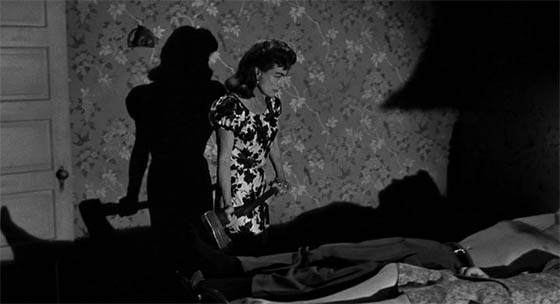 From the late 50’s to the early 60’s, William Castle was on a roll, cranking out one B-picture after another, each generally tempering some classy and competent direction with shameless gimmickry. By early ’64, he was pulling back on the gimmicks, but that doesn’t mean that Strait-Jacket isn’t shameless. The film came in the wake of Whatever Happened to Baby Jane? (1962), an unlikely horror film that resuscitated the careers of two Hollywood stars of the 30’s and 40’s, Bette Davis and Joan Crawford. Davis used that film’s success to launch a twilight career in the horror/suspense genre, with Hush…Hush, Sweet Charlotte (1964), The Nanny (1965) and The Anniversary (1968) for Hammer Films, and, later, Burnt Offerings (1976) and The Watcher in the Woods (1980). Crawford also relished being in the spotlight again, whatever the circumstances, and when Castle, a Baby Jane fan, arrived on bended knee with a script by Psycho author Robert Bloch, she accepted – so long as she ruled like a queen on the set. The result was Strait-Jacket, filmed in 1963, the year that saw the release of two William Castle films which were not horror. Strait-Jacket, a psychological thriller with plenty of shocks, would be a return to form for the director/producer/showman.
From the late 50’s to the early 60’s, William Castle was on a roll, cranking out one B-picture after another, each generally tempering some classy and competent direction with shameless gimmickry. By early ’64, he was pulling back on the gimmicks, but that doesn’t mean that Strait-Jacket isn’t shameless. The film came in the wake of Whatever Happened to Baby Jane? (1962), an unlikely horror film that resuscitated the careers of two Hollywood stars of the 30’s and 40’s, Bette Davis and Joan Crawford. Davis used that film’s success to launch a twilight career in the horror/suspense genre, with Hush…Hush, Sweet Charlotte (1964), The Nanny (1965) and The Anniversary (1968) for Hammer Films, and, later, Burnt Offerings (1976) and The Watcher in the Woods (1980). Crawford also relished being in the spotlight again, whatever the circumstances, and when Castle, a Baby Jane fan, arrived on bended knee with a script by Psycho author Robert Bloch, she accepted – so long as she ruled like a queen on the set. The result was Strait-Jacket, filmed in 1963, the year that saw the release of two William Castle films which were not horror. Strait-Jacket, a psychological thriller with plenty of shocks, would be a return to form for the director/producer/showman.
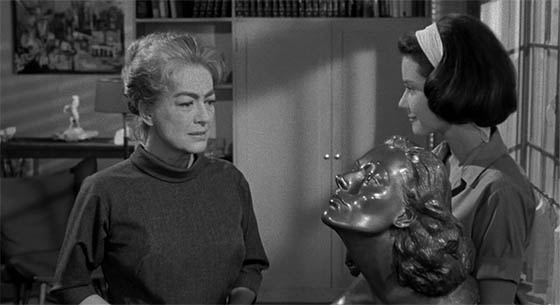
Lucy (Joan Crawford) examines a bust made in her honor by her daughter Carol (Diane Baker). The bust was actually modeled on the younger Crawford and from her personal collection.
Crawford plays Lucy Harbin, who, in the opening scene, returns home early from a trip, and discovers her husband (Lee Majors) in bed with another woman. While her young daughter Carol bears witness, Lucy grabs an axe and decapitates the two lovers, then continues chopping with all the dexterity of a female Paul Bunyan. A semi-psychedelic montage shows Lucy in the insane asylum – it’s necessary for the title, after all, to get Crawford into a strait-jacket, and she screams with gusto – before we flash forward twenty years later. A gray-haired Lucy heads back to her farm to stay with her brother and sister-in-law, as well as Carol, now a beautiful young woman and played by Diane Baker (Journey to the Center of the Earth). Carol, who sculpts as a hobby, is being courted by Michael (John Anthony Hayes), from a well-to-do family. As you might expect, Lucy’s arrival initiates ominous happenings: she sees severed heads lying beside her pillow at night, and is haunted by a child’s chilling nursery rhyme that no one else seems to hear. Increasingly unstable, Lucy – who covers her gray hair with a raven-black wig given her by Carol, and masks her face in makeup to cover her wrinkles – makes a touchy-feely pass at Michael in front of her daughter. Michael looks a bit uncomfortable.
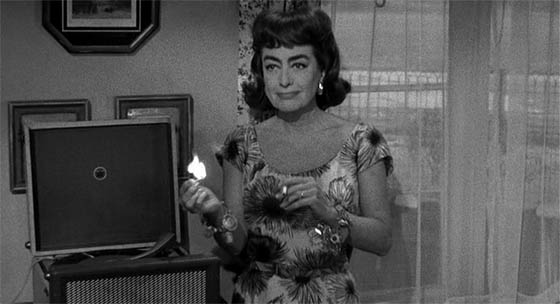
Lucy (Joan Crawford) uses her record player to light a match.
An unwelcome visit by Dr. Anderson, from her old asylum, sends Lucy further off the deep end. (The doctor is played by Mitchell Cox, a board member of Pepsi-Cola, which Crawford, widow of Pepsi’s CEO, never failed to promote. A box of Pepsi soft drinks is prominently displayed in the kitchen.) When Dr. Anderson confronts Lucy alone, her meltdown is spectacular. First she turns on the record player full-blast, then she lights her cigarette by striking a match on the record, and within a minute she’s screaming hysterically at him. Dr. Anderson lingers about the farm, which proves a mistake when an unseen stalker decapitates him with an axe.
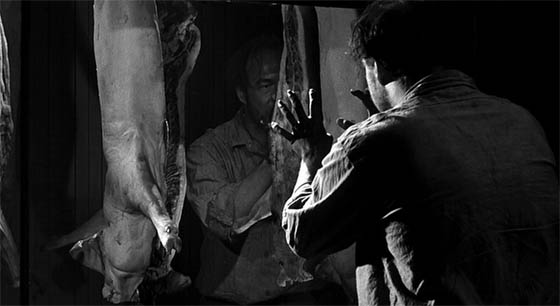
Leo (George Kennedy) inspects the pigs.
Carol suspects foul play when she realizes Dr. Anderson’s car has been parked at the house all evening, so, Norman Bates-style, she decides to cover up the crime by hiding the car. Leo (George Kennedy), a snoopy farmhand, takes advantage of the situation by stealing the car for himself; in the morning, Carol discovers him casually repainting it. She tries to fire him, but he knows he has too much dirt on the Harbin family to take a fall; he refuses to leave. Naturally, he’s not long for this world.
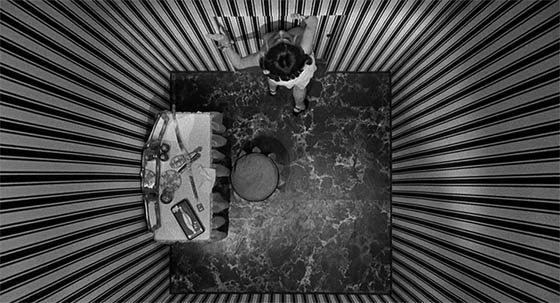
Lucy (Crawford), in hysterics, envisions her dressing room as another prison.
If you can see where this is all going, it’s because it’s all pretty damn obvious. Bloch’s screenplay might have been more effective in 1964; to a modern viewer, the central twist feels too mundane. The influence of both Henri Georges-Clouzot’s Les Diaboliques (1955) and, of course, Hitchcock’s Psycho (1960) began a wave of twist-filled thrillers, many of them coming from Hammer Studios and the pen of Jimmy Sangster. After you’ve seen a lot of these, it’s hard to watch Strait-Jacket without doubting the narrative you’re being handed, and to begin prematurely guessing the identity of the real killer. Ironically, Castle handled these feints better with 1961’s Homicidal, with its truly left-field twist – a film which owed its existence to Psycho. (Apparently, Bloch had no hard feelings about that.) Yet Strait-Jacket still has much to recommend it for the curious. Like Homicidal, the violence is surprisingly explicit – we see heads getting separated from their bodies, however bloodlessly. George Kennedy’s murder is particularly spooky, set in a darkly-lit slaughterhouse where pigs are hanging from hooks. Diane Baker and Joan Crawford make a convincing mother-daughter team (even if Crawford is playing a character about twenty years younger than she really was); both are strong actors, and Crawford chews the scenery like a pit bull. She’s best before she dons that ghastly wig, though a final speech – delivered as though she’s playing a completely different character – is ludicrous. Double bill this with her equally absurd Johnny Guitar (1954) for an evening of campy fun.









